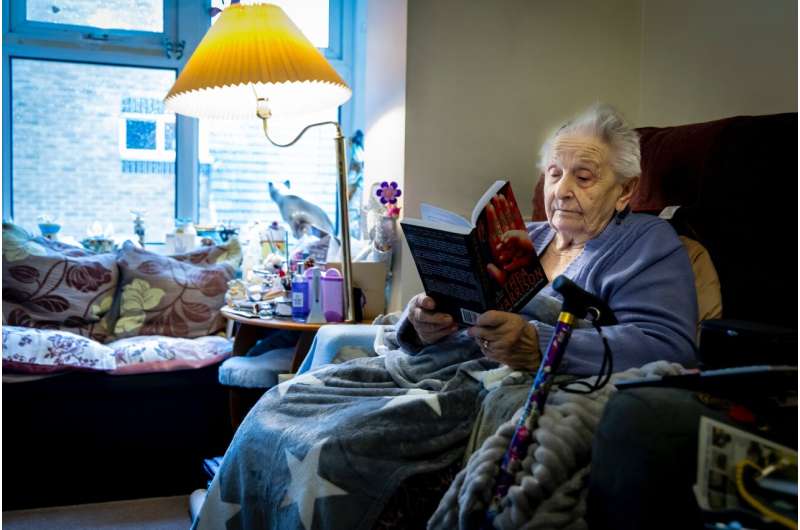This article has been reviewed according to Science X's editorial process and policies. Editors have highlighted the following attributes while ensuring the content's credibility:
fact-checked
peer-reviewed publication
trusted source
proofread
Study of national data demonstrates the value of acute hospital care at home

Since the Centers for Medicare and Medicaid Services launched the Acute Hospital Care at Home (AHCaH) Waiver in 2020, thousands of patients from across 300 hospitals in 37 states have been treated in their homes. Yet little is understood about these patients' outcomes on a national level, and the waiver will end in December 2024 unless there is an act from Congress.
A new study by investigators from Mass General Brigham has analyzed outcomes from AHCaH for a diverse group of patients across America. The study provides preliminary evidence suggesting that home hospital is an important care model for managing acute illness, including among socially vulnerable and medically complex patients. Results are published in a research letter in Annals of Internal Medicine.
"For hundreds of years, since the inception of hospitals, we've told patients to go to a hospital to get acute medical care. But in the last 40 years, there's been a global movement to bring care back to the home," said corresponding author David Michael Levine, MD, MPH, MA, clinical director for research and development for Mass General Brigham's Healthcare at Home.
"We wanted to conduct this national analysis so there would be more data for policymakers and clinicians to make an informed decision about extending or even permanently approving the waiver to extend opportunities for patients to receive care in the comfort of home."
Advances in health care technology have made it more possible than ever to offer treatment options to patients in their home rather than requiring office or hospital visits. In addition, Levine and other investigators from across Mass General Brigham are conducting rigorous, national-level research to present data relevant to clinicians, patients, caregivers and policymakers to inform decisions about the acute hospital care at home model.
Levine and colleagues looked at clinical characteristics and outcomes from all of the 5,858 patients from across the U.S. who were cared for under the AHCaH Waiver, using Medicare fee-for-service Part A claims filed between July 1, 2022 and June 30, 2023. Then they studied whether these clinical characteristics varied across different demographic groups.
Of the study group, 54% of the patients were female, 85.2% were white, 61.8% were over 75 years old, and 18.1% were disabled. The mean household income was $83,932.
When the team studied hospitalizations among all these patients, they found a 0.5% mortality rate and 6.2% escalation rate (returning to the hospital for at least 24 hours). In addition, within 30 days of discharge, 2.6% of patients used a skilled nursing facility, 3.2% died, and 15.6% were readmitted.
"Home hospital care appears quite safe and of high quality from decades of research—you live longer, get readmitted less often, and have fewer adverse events," Levine said. "If people had the opportunity to give this to their mom, their dad, their brother, their sister … they should."
The patients included in the current study had medically complex conditions, including 42.5% with heart failure, 43.3% with chronic obstructive pulmonary disease, 22.1% with cancer, and 16.1% with dementia. The five most common discharge diagnoses were heart failure, respiratory infection (including COVID), sepsis, kidney/urinary tract infections, and cellulitis.
"There are a number of reasons we think hospital-level care is better at home," Levine said. "For one, the discharge process is smoother since we show patients how to take care of themselves right in their homes, where they are also more likely to be upright and move more. In addition, the clinical team has a greater ability to educate and act on the social determinants of health that we see in the home. For example, we can discuss a patient's diet right in the kitchen or link a patient with resources when we see the cupboards are bare."
The outcomes were also stratified by patients of Black and Latine race and ethnicity, dual-eligible status, and by disability status. The findings were consistent across all groups.
"It was reassuring to see that there were not clinically meaningful differences in outcomes across marginalized populations because we know that there are massive disparities in outcomes for traditional hospitalization," Levine said. "This suggests home hospital can really reach a diverse group of patients and families."
Still, the findings are limited to observational data, and additional research is necessary to compare the measured outcomes to those at brick-and-mortar hospitals. Levine's team is also currently studying home hospital care for rural patients, who were not well represented in the current study.
"For decades, home hospital care has been offered all around the world," Levine said. "This is an important moment in the United States where we might see a paradigm shift in how we deliver a sizeable portion of health care."
More information: Levine, DM et al, Acute Hospital Care at Home in The United States: The Early National Experience, Annals of Internal Medicine (2024). DOI: 10.7326/M23-2264. www.acpjournals.org/doi/10.7326/M23-2264



















